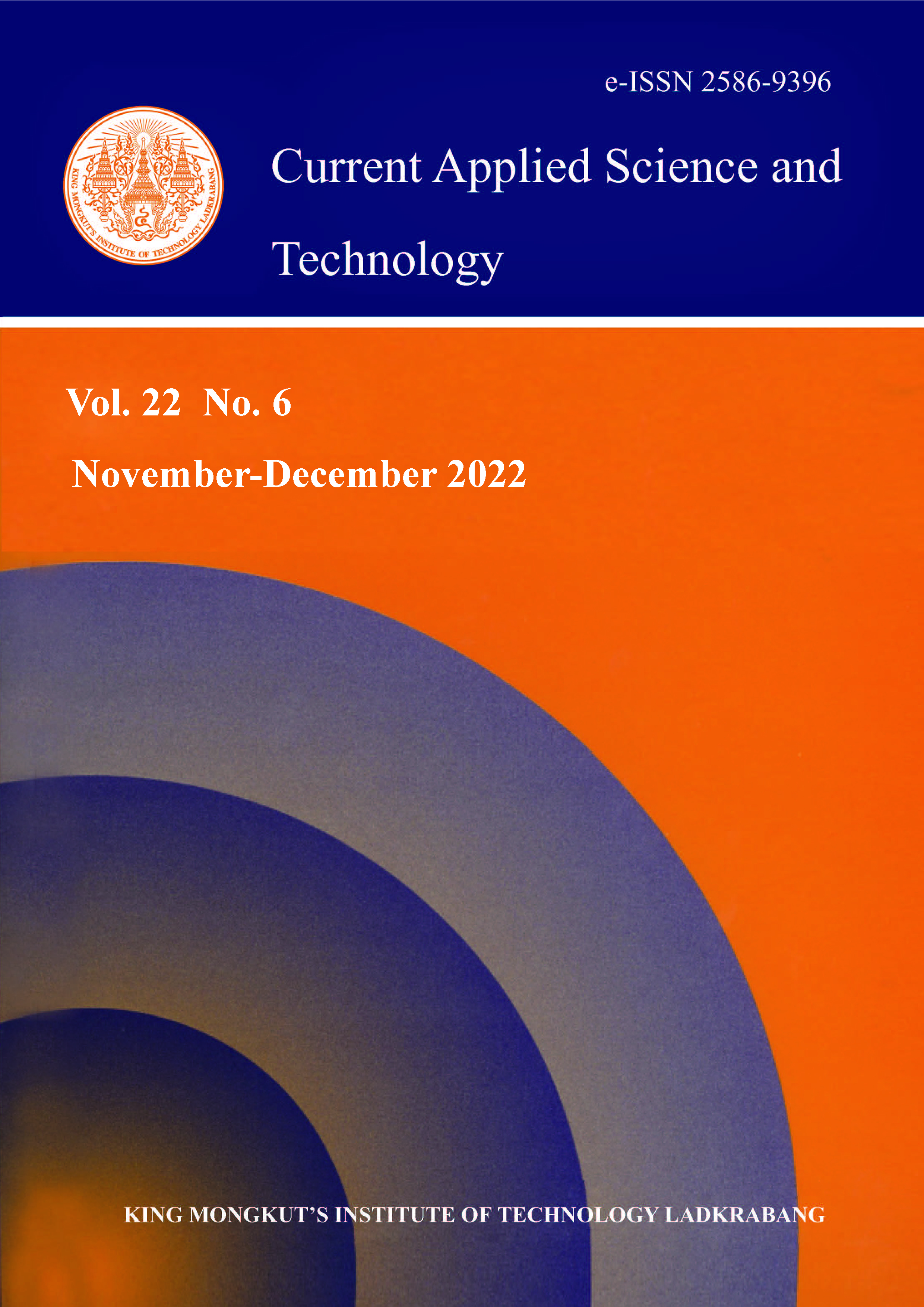Response Surface Optimization of Rhizopus Fungi Immobilization onto Loofah Sponge Using Potato Dextrose
Main Article Content
Abstract
The immobilization process has garnered significant attention in recent years, as it can help avoid the complex procedures of isolation and purification during the fermentation process. Loofah sponge (Luffa cylindrica) has gradually been used as an immobilizing matrix for various microorganisms due to its renewability and pore structure. In this study, the weight of immobilized Rhizopus sp. onto loofah sponge was investigated using a face-centered central composite design (FCCCD). Studied parameters included dextrose concentration (0.02-1.5 M), agitation speed (0-150 rpm), and incubation time (24-72 h). After two sets of experiments consisting of 17 and 11 runs, respectively, and based on the parameter proposed by FCCCD, a maximum biomass weight of 0.252 g was achieved onto 0.3 g of loofah at dextrose concentration of 0.45 M, agitation speed of 100 rpm, and incubation time of 24 h. The SEM results showed well-formed mycelia within and on the loofah surface with no sign of structural degradation.
Keywords: dextrose; loofah sponge; response surface methodology; Rhizopus sp.; immobilization; scanning electron microscope
*Corresponding author: Tel.: (+60) 5 3687588; Fax: (+60) 5 3656176
E-mail: azlinsu76@iium.edu.my
Article Details

This work is licensed under a Creative Commons Attribution-NonCommercial-NoDerivatives 4.0 International License.
Copyright Transfer Statement
The copyright of this article is transferred to Current Applied Science and Technology journal with effect if and when the article is accepted for publication. The copyright transfer covers the exclusive right to reproduce and distribute the article, including reprints, translations, photographic reproductions, electronic form (offline, online) or any other reproductions of similar nature.
The author warrants that this contribution is original and that he/she has full power to make this grant. The author signs for and accepts responsibility for releasing this material on behalf of any and all co-authors.
Here is the link for download: Copyright transfer form.pdf
References
Thongchul, N. and Yang, S.-T., 2003. Controlling filamentous fungal morphology by immobilization on a rotating fibrous matrix to enhance oxygen transfer and L (+)-lactic acid production by Rhizopus oryzae. In: B.C. Saha, ed. ACS Symposium Series 862, Fermentation Process Development. New York: Oxford University Press, pp. 36-51.
Zhang, Z.Y., Jin, B. and Kelly, J.M., 2007. Production of lactic acid from renewable materials by Rhizopus fungi. Biochemical Engineering Journal, 35(3), 251-263.
Ahmadi, M., Vahabzadeh, F., Bonakdarpour, B. and Mehranian, M., 2006. Empirical modeling of olive oil mill wastewater treatment using loofa-immobilized Phanerochaete chrysosporium. Process Biochemistry, 41(5), 1148-1154.
Sattari, S., Vahabzadeh, F. and Aghtaei, H.K., 2015. Performance of loofa-immobilized rhizopus oryzae in the enzymatic production of biodiesel with use of oleic acid in n-hexane medium. Brazilian Journal of Chemical Engineering, 32(2), 367-376.
Ganguly, R., Dwivedi, P. and Singh, R.P., 2007. Production of lactic acid with loofa sponge immobilized Rhizopus oryzae RBU2-10. Bioresource Technology, 98(6), 1246-1251.
Wang, Z., Wang, Y., Yang, S.T., Wang, R. and Ren, H., 2010. A novel honeycomb matrix for cell immobilization to enhance lactic acid production by Rhizopus oryzae. Bioresource Technology, 101(14), 5557-5564.
Efremenko, E.N., Spiricheva, O.V., Veremeenko, D.V., Baibak, A.V. and Lozinsky, V.I., 2006. L(+)-lactic acid production using poly(vinyl alcohol)-cryogel-entrapped Rhizopus oryzae fungal cells. Journal of Chemical Technology and Biotechnology, 81(4), 519-522.
Shahri, S.Z., Vahabzadeh, F. and Mogharei, A., 2020. Lactic acid production by loofah-immobilized Rhizopus oryzae through one-step fermentation process using starch substrate. Bioprocess and Biosystems Engineering, 43(2), 333-345.
Roble, N.D., Ogbonna, J.C. and Tanaka, H., 2003. L-lactic acid production from raw cassava starch in a circulating loop bioreactor with cells immobilized in loofa (Luffa cylindrica). Biotechnology Letters, 25(13), 1093-1098.
He, Q., Shi, H., Gu, H., Naka, G., Ding, H., Li, X., Zhang, Y., Hu, B. and Wang, F., 2016. Immobilization of Rhizopus oryzae ly6 onto loofah sponge as a whole-cell biocatalyst for biodiesel production. BioResources, 11(1), 850-860.
He, Q., Xia, Q., Wang, Y., Li, X., Zhang, Y., Hu, B. and Wang, F., 2016. Biodiesel production: Utilization of loofah sponge to immobilize Rhizopus chinensis CGMCC #3.0232 cells as a whole-cell biocatalyst. Journal of Microbiology and Biotechnology, 26(7), 1278-1284.
Trakarnpaiboon, S., Praneetrattananon, S. and Kitpreechavanich, V., 2018. Simultaneous saccharification and fermentation of L-(+)-lactic acid production from liquefied cassava starch by immobilized Rhizopus oryzae in a 3 L airlift fermenter. Chiang Mai Journal of Science, 45(1), 77-91.
Liu, H., Zhao, S., Jin, Y., Yue, X., Deng, L., Wang, F. and Tan, T., 2017. Production of fumaric acid by immobilized Rhizopus arrhizus RH 7-13-9# on loofah fiber in a stirred-tank reactor. Bioresource Technology, 244, 929-933.
Azmi, A.S., Yusuf, N., Jimat, D.N. and Puad, N.I.M., 2016. Co-production of lactic acid and ethanol using Rhizopus sp. from hydrolyzed inedible cassava starch and leaves. IIUM Engineering Journal, 17(2), 1-10.
Guo, Y., Yan, Q., Jiang, Z., Teng, C. and Wang, X., 2010. Efficient production of lactic acid from sucrose and corncob hydrolysate by a newly isolated Rhizopus oryzae GY18. Journal of Industrial Microbiology and Biotechnology, 37(11), 1137-1143.
Qi, B., Chen, X., Shen, F., Su, Y. and Wan, Y., 2009. Optimization of enzymatic hydrolysis of wheat straw pretreated by alkaline peroxide using response surface methodology. Industrial and Engineering Chemistry Research, 48(15), 7346-7353.






